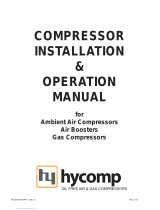1.0 System Design Considerations
8
1.1 General Application Information
Compressors are available for operation in low tempera-
ture R-502, medium temperature R-12, and air condi-
tioning R-22 applications. Design modifications allow the
use of HFC refrigerants R-134a, R-404A, R-407C, and
R-507. This guide provides information and recommen-
dations for the successful application of compressors in
A/C and refrigeration systems.
Maximum operating conditions of the compressor mod-
els are generally defined in the performance curves and
will differ with each model. Operating conditions should
be controlled so that the discharge gas does not exceed
275°F (135°C) at the discharge service valve and that oil
temperature does not exceed 160°F (71°C). For
HFC/POE applications the maximum recommended dis-
charge temperature is 250°F (121°C).
1.2 Compressor Rating Notes
Performance for most standard conditions are plotted in
tabular data or rating curves. For special requests, con-
tact Carlyle Application Engineering. Carlyle also pro-
vides computer software data that allows system design-
ers access to Carlyle compressor performance. Carlyle’s
“CARWIN” software allows customers to determine indi-
vidual compressor and multiple compressor selections.
It gives performance data on various refrigerants in low,
medium and high temperature applications. It also
allows performance adjustments with superheat and sub-
cooling changes. This software can be accessed at
Carlyle’s website:
www.carlylecompressor.com/technical info/Carwin.html.
The compressor capacity and power ratings found in the
06D/E refrigeration compressor specification sheets are
based on the following conditions:
Compressor ratings are based on nominal voltage, 60
hertz (1750 rpm) operation and 50 hertz (1450 rpm)
operation, with 0°F (0°C) subcooling.
Note: Some Carlyle air conditioning ratings are at ARI
(Air Conditioning & Refrigeration Institution) rating con-
ditions and with 15°F subcooling. Ratings may be inter-
polated but not extrapolated.
Liquid subcooling increases system capacity by approxi-
mately 1/2 of 1% for each degree Fahrenheit (.5°C) of
subcooling for R-12, R-22, and R-502. With HFC refrig-
erants R-134a, R-404A, and R-507, the subcooling cor-
rection is higher and in most cases a correction of 6/10
of 1% for each degree Fahrenheit (.5°C) can be used.
When correcting for subcooling, power input to the
compressor motor does not change.
Refrigerant temperatures (suction and condensing or
discharge) are saturation temperatures corresponding to
pressures indicated at the compressor service valves.
Actual gas temperatures are higher because of super-
heat.
Capacities are based on the actual suction gas tempera-
tures to the compressor of 65°F (18°C) for refrigerants
12, 502, 134a, 404A, and 507. It assumes superheating
occurs in the evaporator and in the suction line within
the refrigerated space, or in a liquid-suction heat
exchanger so that all the superheat produces useful
cooling. Superheating that occurs outside the refrigerat-
ed space is a loss, but is a compressor load. If increases
in return gas temperatures are obtained outside of the
refrigerated space or if the compressor is operated at a
lower return gas temperature than 65°F (18°C), a
capacity correction is required. For R-22, ratings at 65°F
(18°C) return gas temperature, the same adjustments as
noted above with R-502 should apply. For R-22 ratings
based on a suction gas superheat of 20°F (-11°C), it is
assumed that all the superheat is useful and the capacity
can be used without adjustment.
Capacity corrections for superheat changes involve a
number of variables and change from compressor to
compressor. In the past correction tables were used to
estimate these performance changes. Today our
“CARWIN” software makes adjustments for compressor
performance differences when the compressor return
gas temperature is changed or the system superheat is
modified. This software can be downloaded from our
website as noted earlier in this section.
Performance data for most refrigerants is based on the
saturated suction and saturated condensing conditions.
This includes refrigerants such as R-12, R-22, R-502,
R-134a and R-404A. Some refrigerants are a mixture
and have a different saturated temperature as a vapor
and liquid at the same pressure. This property is called
“glide”. Refrigerant 404A has what is called a low glide
and is typically treated as an azeotrope refrigerant.
Refrigerant 407C though is considered as having a high
glide and has significantly different saturation pressure
between the vapor and liquid state. When in a vapor
























